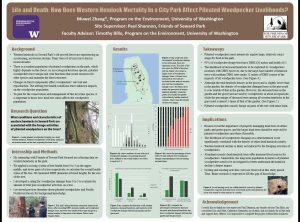Life and Death: How Does Western Hemlock Mortality in a City Park Affect Pileated Woodpecker Livelihoods?
Urban parks are important environments to support native ecosystems. Western hemlocks in Seward Park’s old-growth forest are experiencing a health crisis that causes them to die at a concerning rate. This forest supports a resident pileated woodpecker population, which has irreplaceable functions for the local ecosystem. Both living and dead trees are vital resources for animals living in the forest, especially woodpeckers. Therefore, the altering hemlock survival and health leave unknown impacts on the population of woodpeckers. My study aims to look at the health condition of western hemlocks in the park and how it is associated with the pattern of pileated woodpecker activities. Working with Friends of Seward Park, I identified western hemlocks in the forest and took a set of feature data from each tree. I recorded any pileated woodpecker activity I encountered in the forest and set up camera traps for spot monitoring. According to my data, pileated woodpeckers most intensively exploit large, relatively intact snags for food and nesting in the park. Their activity level is significantly higher in the hemlock graveyard, defined by the most concentrated deceased hemlocks, than in other parts of the park. Western hemlock mortality is not likely caused by woodpecker activities because they almost only occur on already dead trees. My results show the importance of managing woody debris in urban parks. Further research on the population dynamics of pileated woodpeckers should be conducted to monitor the long-term trends, responding to unknown future development of hemlock mortality.
